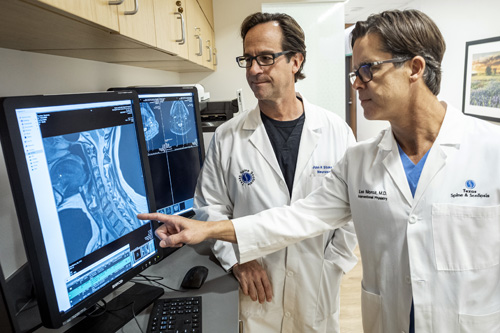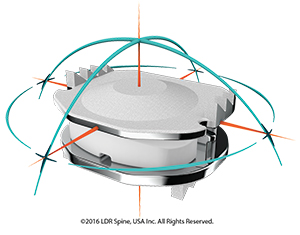
Learn about nonsurgical options to get you back to your everyday activities.
NOTICE: Our main Austin clinic location has moved to 1004 West 32nd Street. Click here for a map.
 The spine surgeons, Dr. John Stokes and Dr. Eeric Truumees, at Texas Spine and Scoliosis in Texas are experienced in caring for and diagnosing a wide range of spinal tumors (neoplasia). Dr. John Stokes is an expert in caring for primary spinal cord tumors, also known as intradural tumors.
The spine surgeons, Dr. John Stokes and Dr. Eeric Truumees, at Texas Spine and Scoliosis in Texas are experienced in caring for and diagnosing a wide range of spinal tumors (neoplasia). Dr. John Stokes is an expert in caring for primary spinal cord tumors, also known as intradural tumors.
Dr. Eeric Truumees is experienced diagnosing and caring for primary and metastatic tumors from the occipito-cervical junction (half of the rotation and flexion extension of the head and neck takes place in this area) to the sacrum (base of the spine). He has been published in this area, including an article in the Journal of the American Academy of Orthopaedic Surgeons entitled "Preoperative Embolization in the Treatment of Spinal Metastasis" and chapters in several textbooks, including Rob McLain’s Cancer in the Spine. Treatment for spinal tumors continues to evolve and the specialists at Texas Spine and Scoliosis in Texas are at the forefront of the latest techniques and approaches for spine tumor treatment, both nonsurgical and surgical. The spine tumor treatment approach used by Dr. Stokes and Dr. Truumees is complementary to medical and radiation oncology.

Beyond surgical modalities, patients with radicular pain due to compression fractures that involve a tumor may benefit from nerve root blocks or other injection therapies.
Items to consider when selecting a treatment plan for spinal tumors include:
It is important for the orthopedic surgeon to have a complete medical history of the patient suffering from a spinal tumor. This includes, understanding the prognosis of the patient, other areas of the body where cancer has spread and how the patient has responded to previous treatment. It is also important that the orthopedic surgeon have communication with the neuroradiologist.
The surgeons at Texas Spine and Scoliosis in Austin, Texas have improved models for understanding the destabilizing effects of spine metastases. This allows them to take preventative action in stabilizing patients at risk for dangerous spinal column failures. This makes for better pain control, medical management and return to activity.

Surgical options for spinal tumors range from percutaneous biopsies and cement stabilization to wide resections of primary tumors. Hybrid, mini-open and less invasive screw and rod stabilization modalities have evolved rapidly as well. Thus, it is important for each treatment strategy to be based on the patient’s short and long term goals.
The usual goal of surgery to remove a spinal tumor is to protect the spinal cord and to control pain. The surgery does not often affect the overall course of the disease. Because nearly two thirds of the lesions that develop are hypervascular, meaning a large number of blood vessels are present. The risk for life-threatening hemorrhage during surgery to stabilize a spine tumor is increased because of this.
A preoperative angiographic assessment
is advised for any
patient undergoing open stabilization
of a spinal tumor. When the angiogram identifies hypervascularity, embolization may be used. Pre-operative embolization is a technique used to obstruct the blood vessels that feed the tumor. Embolization may be used for patients of all ages. For some benign tumors, embolization may be used in younger patients to delay surgery until they are older. Other advantages of embolization include: decreased
blood loss during surgery, improved visibility during surgery and reduced surgery duration. In some
cases, embolization may decrease
tumor recurrence.
Alternatives to embolization focus on various pre- and intraoperative procedures to decrease lesion vascularity or cause the bleeding to stop. In some cases, neo-adjuvant radiation therapy (XRT) or chemotherapy may help to reduce the size of spinal metastases. A reduction in metabolic activity in the tumor may help to reduce the blood flow. It is important to note that preoperative XRT is associated with a higher level of post-op wound complications than embolization. Bleeding can also be lessened by injecting small amounts of sterile alcohol directly into the lesion.2
Treatment decisions in patients with spinal tumors are complex. The surgeon and patient will work together to develop the best treatment plan for each individual patient.
Sources:
1. Gokaslan ZL: Spine surgery for cancer.
Curr Opin Oncol 1996;8(3):178-181.
2. "Preoperative Embolization in the Treatment of Spinal Metastasis"
Truumees et al. J Am Acad Orthop Surg.2010; 18: 449-453
[top]

Learn about surgical and nonsurgical treatment options.

Learn about nonsurgical options to get you back to your everyday activities.

Learn about various surgical procedures performed by Ascension Texas Spine & Scoliosis.

The artificial disc concept is intended to be an alternative for spinal fusion surgery.